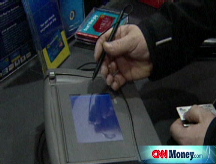Stocks get a boost
Wall Street advances after Fed, other central banks cut rates, lending improves and GDP shrinks at a slower-than-expected pace.

NEW YORK (CNNMoney.com) -- Stocks rallied Thursday, as investors cheered news of easier credit and a report showing the economy shrank at a slower pace than expected in the third quarter.
The Dow Jones Industrial average (INDU) gained 190 points, or 2.1%. The Standard & Poor's 500 (SPX) index rose 2.6% and the Nasdaq composite (COMP) gained 2.5%.
All three major gauges had been higher in the early going, but the buying momentum eased a bit as the session wore on.
Stocks seem to be in the process of putting a bottom in place, said Gary Hager, founder and chief executive of Integrated Wealth Management, citing the recent bear market lows hit on Oct. 10.
Looking forward, he said "We're still going to see significant swings, but the volatility should start to decrease once we get past the election and get through the end of the year."
Rate cuts: Stocks zigzagged Wednesday after the Federal Reserve cut interest rates, as expected, and also issued a dour assessment of the economy. The central bank cut the fed funds rate, a key bank lending rate, by half a percentage point to 1.0%. That matched an all-time low for the rate last seen in June 2004.
In its statement, the central bank painted a bleak picture of the economy, touching on the lingering impact of the financial market crisis, the lack of available credit, and the erosion in consumer and business spending. The statement indicated the Fed could cut rates again if necessary.
But world markets rallied on the news, with Asian exchanges surging overnight and European markets up at the close. Hong Kong and Taiwan cut interest rates Thursday following the actions by the Fed, and by China earlier Wednesday. Speculation mounted that Japan would cut its key rate at a meeting this Friday.
The Fed has cut rates for more than a year in an attempt to help the struggling economy. The central bank has also made potentially trillions available to financial institutions as part of a broader attempt to calm roiling financial markets and get banks to start lending to each other again.
Lending has been improving slowly. On Thursday, the Fed said that the market for commercial paper grew last week, the first such expansion in nearly two months. Commercial paper is a critical form of short-term funding that companies rely on for their daily operations.
Lending rates: The credit market continued to improve, with Libor, the overnight bank-to-bank lending rate, falling to 0.73% from 1.14% Wednesday, according to Bloomberg.com. The 3-month Libor fell to 3.19% from 3.42% Wednesday. (Full story)
The TED spread, the difference between what banks pay to borrow from each other for three months and what the Treasury pays, narrowed slightly to 2.82% from 2.84% Wednesday. The spread hit a record 4.65% earlier this month. The narrower the spread, the more willing banks are to lend to each other.
The yield on the 3-month Treasury bill, seen as the safest place to put money in the short term, slipped to 0.4% from 0.57% late Wednesday, with investors preferring to take a piddling return on their money than risk the stock market.
Last month, the 3-month yield reached a 68-year low around 0% as investor panic hit its highest level.
Treasury prices slipped, raising the yield on the benchmark 10-year note yield to 3.97% from 3.85% late Wednesday. Treasury prices and yields move in opposite directions.
GDP: Gross domestic product, the broadest measure of the nation's economy, fell at an annual rate of 0.3% in the third quarter after growing at a 2.8% rate in the second quarter.
The drop was not as bad as expected, with analysts having forecast that GDP would slump 0.5%. However, the decline was still the worst performance for the economy since the last recession 7 years ago. (Full story)
Company news: Exxon Mobil (XOM, Fortune 500), the oil services giant, reported a profit of $14.83 billion, the biggest quarterly profit in U.S. history. Shares rose modestly. (Full story)
But Exxon was an exception. With roughly 59% of the S&P 500 results out, profits are currently on track to have fallen 23.8% versus a year ago, according to the latest data from tracking firm Thomson Reuters.
Hartford Financial Services (HIG, Fortune 500) tumbled 51.6% after the life insurer reported a massive quarterly loss and also cut its full-year profit forecast.
Motorola (MOT, Fortune 500) warned that fourth-quarter profit would miss forecasts and said its troubled cell phone unit will continue to weaken next year. As a result, the company will delay its planned spinoff of that unit. The company will also cut 3,000 jobs as part of a restructuring. Motorola shares fell 5.3%.
Avon Products (AVP, Fortune 500) reported weaker-than-expected quarterly profit and warned that the impact of the recently stronger dollar will hurt fourth-quarter and full-year growth rates. Shares fell 15.4%.
In other company news, American Express (AXP, Fortune 500) announced that it will cut 7,000 jobs, or more than 10% of its staff, amid the ongoing credit crisis.
Dow component GM (GM, Fortune 500) slumped over 10% amid ongoing woes for the company and the auto sector. The governors of six states sent a letter to federal officials asking that they intervene to help the hard-hit domestic automakers. GM and Cerberus, the parent of Chrysler, are in talks about a merger, but need financing.
Also impacting the stock was GMAC, the troubled auto finance and mortgage lending company that's 49% owned by GM. GMAC said it's in talks with federal regulators to become a bank holding company, so that it can access government funds. Complicating matters further, Cerberus owns the other 51% of GMAC.
Market breadth was positive. On the New York Stock Exchange, advancers beat decliners by four to one on volume of 1.38 billion shares. On the Nasdaq, winners beat losers five to two on volume of 2.55 billion shares.
Other markets: The dollar fell against the euro and gained versus the yen.
U.S. light crude oil for December delivery fell $1.54 to settle at $65.96 a barrel on the New York Mercantile Exchange.
COMEX gold for December delivery fell $15.50 to settle at $738.50 an ounce.
Gasoline prices fell another 4 cents overnight, to a national average of $2.547 a gallon, according to a survey of credit-card activity by motorist group AAA. It was the 43rd consecutive day that prices have decreased. During that time, prices have fallen by $1.31 a gallon, or nearly 34%.
A good week, a brutal month: Stocks have bounced back this week, finding some momentum at the end of a wretched October. For the week, the S&P 500 is up 8.8% as of Thursday's close.
But at the same time, investors pulled more money out of equity mutual funds than they did in the previous week, according to tracking firm Trim Tabs. The amount of money withdrawn from stock mutual funds in the week ended Oct. 29 rose to 9.2 billion from 6.5 billion the previous week.
Despite the recovery, October will go down in the history books as one of Wall Street's worst months of all time.
As of Thursday's close, the Dow had lost 1,670 points, the Dow's worst month ever, according to Stock Trader's Almanac info going back to 1901. On a percentage basis, the decline of 15.4% doesn't rank in the top ten.
The S&P 500 lost nearly 212 points, or 18.2% in the month, and is currently on track to post its worst month ever on a point basis and ninth worst ever on a percentage basis, going back to 1930.
The Nasdaq dropped 384 points, or 18.4% in October, tracking its seventh-worst month ever on a point basis and its sixth-worst month on a percentage basis, going back to its inception in 1971.
October also brought lows that could constitute a market bottom, analysts say. However, bottoming out is a process. In the last bear market, stocks made lows in the summer of 2002, "retested the lows" in October 2002, and then retested them once more in March 2003 before finally making a sustained gain over the next few years.
The major gauges seem have hit a low on Oct. 10, when the Dow dipped below 7,900 and the S&P 500 fell below 840. The Nasdaq initially made a low on that same date, before retesting it a few weeks later and falling below 1,500. Stocks may need to fall back to those lows again before moving higher this time.
Although with the depth of the recession and the ongoing credit crisis, the stock market now is not likely to see an advance comparable to the more than 4-year bull market that followed the last bear market.
"Stocks are building a good base right now," said Will Hepburn, president and chief investment officer at Hepburn Capital Management.
He said that stocks will likely keep moving sideways in the short term, but could be setting up for a multi-month rally six months out as the economy begins to stabilize and banks start lending again. ![]()




